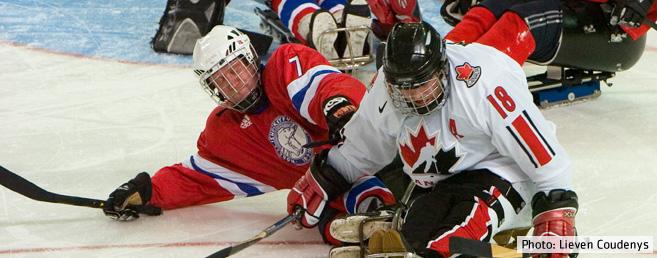Para-ice hockey is open to athletes with a physical impairment. Athletes are required to submit medical reports and meet the minimum impairment criteria in order to compete. Eligibility is determined by trained Classifiers.
For more information on Eligible Impairments and Classification please see the Para-ice hockey Information Sheet (PDF – 92KB) – updated August 2024.
Protective Gear
Because of the physical nature of the game, all players are required to wear a helmet with a full cage or mask as well as a protective collar or bib. Players are also encouraged to wear protective padding, including shoulder pads, shin guards, elbow pads and large padded gloves. In addition, the goalkeeper wears leg pads, body pads, a helmet with a visor and a catcher glove to protect the athlete from pucks flying up to 100 km/h.
Puck
Made of vulcanised rubber or any other approved material, the puck is 2.54cm thick, with a diameter of 7.62cm and weighs 156 to 170 grams.
Sledge
Made of aluminium or steel, sledges are 0.6m to 1.2m in length with a curved front end and one of two different seating systems. The sledge is set on two blades, which are usually made of tempered steel and are each 3 mm thick. The puck must be able to pass underneath the sledge. The height of the main frame must be between 8.5cm to 9.5cm above the ice, and the length of the blade may not be more than one-third of the total length of the sledge. The sledge may be equipped with a backrest, but it must not protrude laterally beyond the armpits when the player is properly seated. Straps secure a player’s feet, ankles, knees and hips to the sledge.
Stick
The word Hockey comes from the French word hocquet, which means hooked stick. In Ice Sledge Hockey, players use two sticks with a hooked wooden blade at one end (for puck handling and ambidextrous shooting) and a pick at the other end. Each stick has a maximum length of 1m and is made of wood, plastic or aluminium/titanium. The blade has a maximum length of 25cm, except for the goaltender’s blade, which has a maximum length of 35cm. The pick end of the stick must not damage the ice surface or inadvertently puncture or slash other players, so the following rules apply:
- No part of the pick or teeth may come to a sharp point.
- The pick must not extend more than 1cm anywhere beyond the stick.
- The pick must have at least six teeth, each with a maximum length of 4mm.
The goaltender may have an additional pick at the base end of his stick. The goaltender may also use an additional stick with a blade or a trapper glove with teeth.



 Join AUS Squad
Join AUS Squad